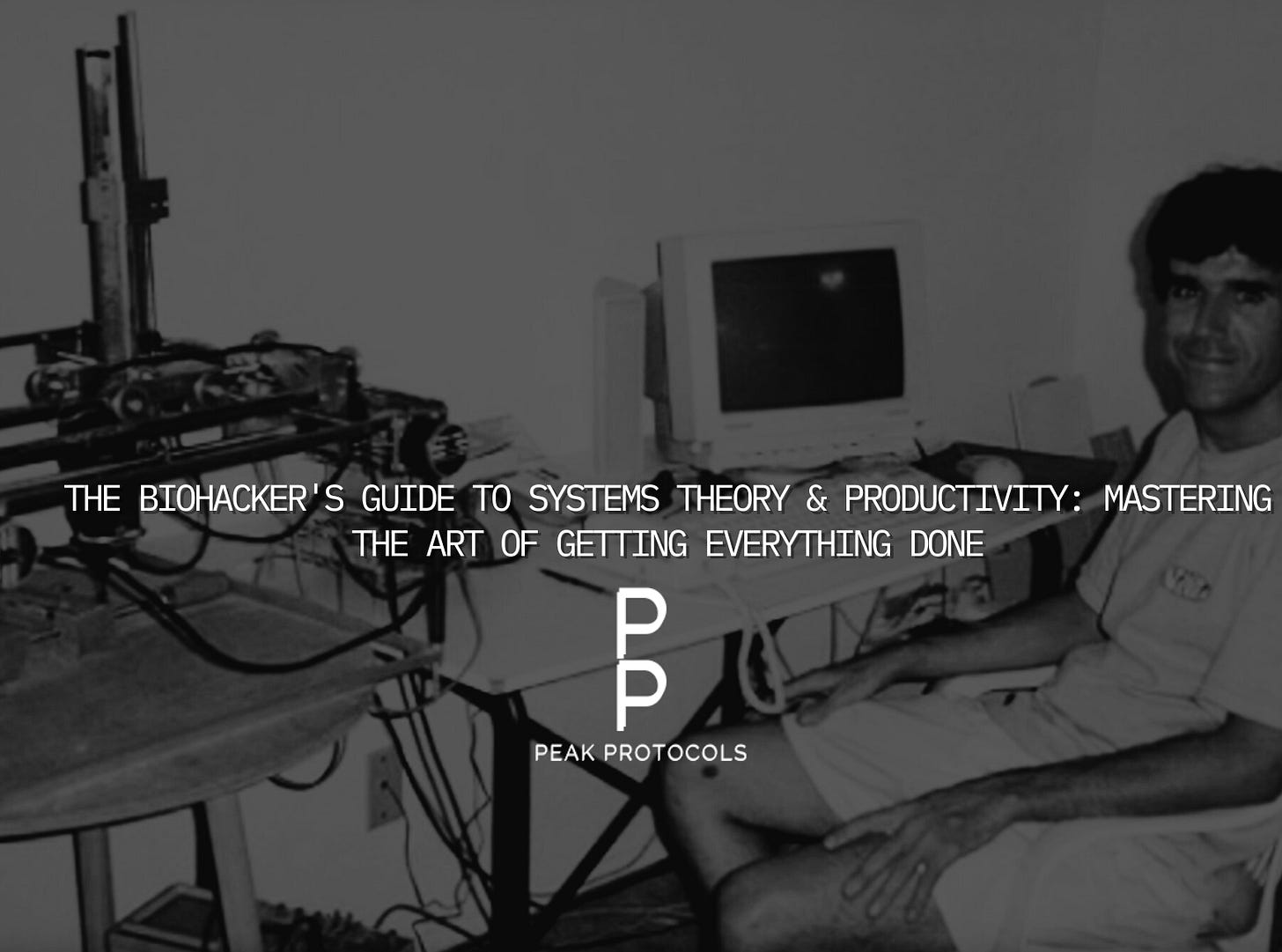The Biohacker's Guide to Systems Theory & Productivity: Mastering the Art of Getting Everything Done
Productivity just got a whole lot easier #4
In the realm of human potential, while IQ might be relatively fixed, our capacity to reshape our thinking patterns and purposeful actions knows no bounds. This guide emerges as a natural evolution from my previous work on rapid skill acquisition—an article that resonated with thousands, sparking countless discussions, consultations, and meaningful exchanges with readers worldwide.
As someone deeply immersed in optimizing human performance, I've discovered that the intersection of systems theory and productivity holds transformative potential. This realization crystallized during a pivotal period in my life when I was managing every aspect of my work without delegation—a challenge that compelled me to develop extraordinarily effective productivity systems.
The framework I’m about to share isn’t just another productivity guide. It’s a comprehensive approach to leveraging systems theory for exponential gains in personal effectiveness. As Niklas Luhmann, one of history's most prolific and productive scholars, famously lamented: “If anything I wish I had, it was more time.” Through this guide, you’ll learn to master your time so thoroughly that you’ll accomplish more than you ever thought possible, with hours to spare.
Drawing from my signature approach to knowledge sharing, I’ll present this material through clear principles, actionable maxims, and Feynman-inspired frameworks. My goal is to make these powerful concepts accessible to everyone—whether you’re a curious beginner or an accomplished academic.
Understanding Systems: The Foundation
At their core, systems are far more than mere collections of parts—they are intricate webs of interconnected components working in concert. Consider the human body: it stands as nature’s masterpiece of systemic complexity, where countless processes and elements function in precise harmony to create something far greater than the sum of its parts. This fundamental understanding of systems will form the bedrock of our approach to exponential productivity.
The Law of Complementarity
Niels Bohr’s complementarity principle states that certain physical properties are complementary—they cannot be observed or measured simultaneously. This principle is key to building effective systems. We may not immediately see the outcomes of our efforts; sometimes, results emerge only after years of consistent action. It has taken me years to refine my personal systems and frameworks, and I’m only now starting to see the full dividends of those efforts.
To succeed, you must develop the ability to create individual frameworks, like an architect, and let them work in harmony with one another to achieve personalized results. While I cannot lead you by the hand as you create your systems, I can provide insights into my own. These insights will help you combine logic and creativity to develop a system tailored to achieving your highest goals.
Information Processing Optimization: External Systems for Memory
Many productivity gurus tout the latest tools and cutting-edge gadgets while overlooking one of the simplest yet most powerful productivity tools of all time: the whiteboard. Cost? Minimal. Effect? Maximal. Some of the greatest ideas in history were born with a pen, paper, and whiteboard.
Externalizing your thoughts is crucial for creative thinking—it frees up mental space for new ideas, a phenomenon rooted in the Zeigarnik effect. As a productivity enthusiast, you must have this tool in your arsenal.
Building on the Organic: Internal Ideas and Notes
How are ideas and systems built? Take a moment to consider: how do you form connections? Through your thoughts, yes? But how do they function?
Imagine listening to music and being reminded of another song that feels similar. A particular synth or drum beat evokes a familiar tune, sparking a chain of thought. This same process applies to all forms of creative ideation. Systems often emerge from seemingly irrelevant connections.
As you read this guide, keep an open mind. My role as a writer is to teach you how to build on organic thought and think for yourself. Only then can you unlock truly creative, productive output.
Remember, systems only work if you do. They must be understood and mastered by their creator. Even the most powerful tools are useless unless the user knows how to wield them.
In the words of Terry Davis:
"An idiot admires complexity; a genius admires simplicity. A physicist tries to make it simple. For an idiot, the more complicated it is, the more he will admire it. If you make something so clusterfucked he can't understand it, he's gonna think you're a god because you made it so complicated nobody can understand it. That’s how they write journals in academics—they try to make it so complicated people think you’re a genius."
Inspired by Terry’s wisdom, I’ll now outline my systematic approach to health and productivity in simple, straightforward terms. No clusterfucks—just clear, actionable guidance.
My System: Organic Thinking Combined with AI
My system is grounded in organic thinking, enhanced by AI. I use a funneling system for ideas, starting with a whiteboard, pen and paper, and my phone’s notes app. No idea goes to waste.
Once I’ve gathered my thoughts, I transfer them into Obsidian, a note-taking app. There, I add tags and connections to organize and build upon my ideas. Over time, this structured repository becomes a powerful resource I can reference for future projects. One of the things I use Obsidian for is to track past ideas for health protocols that have worked on clients, such as mycotoxin exposure and the things that can rectify it.
By combining simplicity and systematic rigor, this approach has allowed me to maximize my creative and productive potential. With the principles shared here, I hope you can do the same.
Attached below is Obsidian.
But That’s Not All I Use—Far From It
This is just one component of a grand scheme of tools. The entire chain of my system is to be revealed now. Meet my tool bar, otherwise known as the chain.




